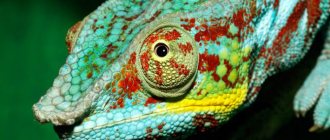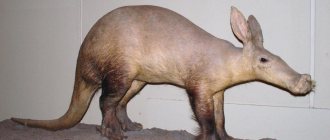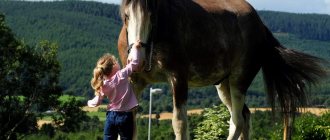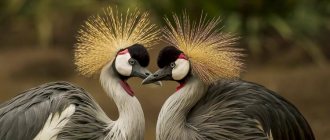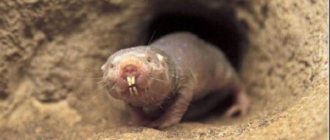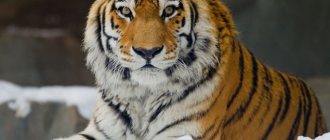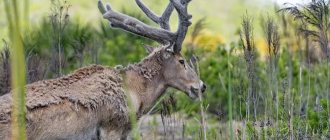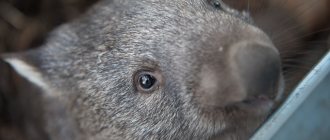The fauna of China is interesting and diverse. Unfortunately, the country's population growth, environmental fragmentation, pollution and drying up of water bodies, poaching and much more are negatively affecting China's fauna. Over the past 50 years, the population of some species has declined significantly, while other species have become extinct. However, the country's government is currently committed to conserving many endangered species and creating various conservation areas where animals can breed and restore their populations.
Roxellanov's rhinopithecus
This animal is common in the mountain forests of Southwestern China at an altitude of 1500-3400 m above sea level. Of the three species of Rhinopithecus in China, Roxellana Rhinopithecus is the most widely distributed throughout the country.
Snow is common throughout its range, and it can withstand colder average temperatures than any other primate. Its diet varies greatly between seasons, but it is primarily a herbivore, spending about 97% of its life in trees. Population estimates range from 8,000 to 15,000 individuals. The main threat to the animal's extinction is loss of habitat.
Bactrian camel
photo
The wild Bactrian camel (Camelus bactrianus) is now extremely rare in the desert of Northern China. They have long been domesticated and are used to provide transportation across large areas. These camels skillfully withstand significant temperature fluctuations - from severe cold to excessive heat. They have the remarkable ability to go without water for months, but when water is available they can drink up to 57 liters at a time. The movement speed of a Bactrian camel is up to 65 km/h. He is a good swimmer and has well-developed eyesight and sense of smell. The population density of wild Bactrian camels is calculated as 5 animals per 100 km².
The fauna of China in the far south includes the giant squirrel, flying dog, tupaya, palm marten, slow loris and white-handed gibbon.
Chinese tiger
The Chinese tiger is a subspecies of tigers that was historically found in southern China. This animal is on the verge of extinction as they have not been seen in the wild since 1970. Currently, about 20 individuals can only be found in captivity in China.
The weight of these tigers can reach 110-150 kg, and the body length is 2.3-2.6 m. This subspecies has short but wide stripes. Chinese tigers are believed to be the fastest of tigers and excellent hunters, capable of chasing prey for many hours.
Himalayan bear
This bear is also called the moon bear. The white collar on the animal's chest resembles a crescent moon. It “shines” in Tibet. The bears that live here are 2 times smaller than brown ones. However, representatives of the species are distinguished by the largest ears among their relatives.
Their round shape resembles panda ears. Himalayan bears are also close to them due to their arboreal lifestyle. Animals spend approximately half of their century on branches.
Moon bears especially love bird cherry bushes. Its fruits are a delicacy for Himalayan species. Since bird cherry tends to grow in floodplains, bears also gather there during harvest.
White-breasted animals living in China also love to eat honey. For his sake, sometimes animals destroy apiaries. Not only Chinese, but also Russian beekeepers are under attack. Himalayan bears enter the territory of a country neighboring China, in particular, the Ussuri region.
Like brown bears, Himalayan bears hibernate, but they do so above ground. White-breasted birds climb into the hollows of large trees. The minimum height of the den is 5 meters above the ground.
Himalayan bear
Brown eared pheasant
The brown eared pheasant is a large, dark brown bird endemic to the mountain forests of northeastern China. This species is the rarest of the eared pheasants genus, its diet consisting mainly of roots, bulbs and vegetation. Although they are protected under Chinese law, these animals are considered vulnerable due to fragmentation, deforestation and hunting, according to the IUCN. The species is also listed on Appendix I of CITES.
Slow loris
photo
The slow loris (Nycticebus coucang), despite its slowness, deftly catches various arboreal animals. It feeds on various fruits and other plant foods. Local residents call this interesting nocturnal animal kukang .
Its body length is about 40 cm, and its weight is 1.5 kg. This type of loris can live harmoniously in small, apparently family groups. The female gives birth to one baby, which, as soon as it is born, clings tightly to the mother’s fur. Tags Nature conservation
Chinese alligator
The Chinese alligator is a species endemic to eastern China that does not breed well in captivity. In the wild, according to scientists, there are about 150 individuals left, which indicates that the species is on the verge of extinction. The main threats to the extinction of the animal are the reduction of its natural habitat and poaching.
To solve the problems of captive breeding, scientific technology staff dug a pond, planted trees around it and built an island to mimic conditions in the wild. Under the supervision of specialists, these animals began to breed in captivity in 1980. Currently, these alligators live in this comfortable environment with their brood. The population is gradually increasing.
Rare animals of China
The nature of the Celestial Empire is rich in unique species of animals, many of which have long been on the verge of extinction: the Giant Panda, the Asian Ibis, the Chinese river dolphin, the golden snub-nosed monkey, the Chinese tiger, etc.
Giant panda – Big Panda
These funny black and white bears live in the area of bamboo forests in the southwest of the Celestial Empire. Giant pandas, or Bamboo bears, are considered one of the rarest animals on the planet...
Listed in the IUCN Red List in 1990. The most optimistic estimates place the total number between 1,000 and 2,000, with another 200 living in captivity.
In the wild, the giant panda lives among the mountain ranges of Sichuan, Shaanxi, Gansu and the provinces of Central China. They previously lived in the lowlands, but deforestation and other human activities have forced pandas to move up into the mountains.
Interesting things on the website Holidays in China by month
It feeds exclusively on bamboo, sometimes other grasses or small rodents. In zoos, they are fed bamboo, sugar cane, rice and other foods containing high levels of fiber. Adults live separately, meeting only occasionally. Cubs live with their mothers for up to one and a half to three years.
Asian Ibis
The height of the bird is more than 80 cm, has a long key and red cheeks. The head of the Ibis is partially without feathers, only on the back of the head there is a crest of white feathers.
Over the past 30 years, the population has increased from 7 to 700 individuals, with about 700 more living in captivity.
The Ibis bird is common in China, Japan, Russia, and Korea. The decline in numbers was caused by overfishing and a decrease in the animal’s habitat.
Ibises live in wetlands, make nests in treetops, and hunt small fish, frogs, snails and insects. A female ibis can lay up to 4 eggs at a time. A hatched ibis chick learns to fly and get food on its own within a month.
Chinese river dolphin or White flag
It was named White Flag because of the color of its dorsal fin. This species of dolphin is on the verge of extinction, and some scientists believe that it is already extinct. Listed as endangered by the IUCN in 1996. An expedition sent in 2006 to search for him failed to find him. However, in 2007, a Chinese farmer managed to film this animal. The dolphin lives in the largest river in China - the Yangtze.
The habitat is only fresh water, the dolphin has very poor eyesight. The ancient Chinese worshiped the dolphin as a river goddess and offered prayers to it every time they went fishing. The dolphin is an ancient species that appeared twenty million years ago.
Golden snub-nosed monkey
This is one of the most unique and beautiful species of monkeys on the planet. The scientific name of the monkey is Rhinopithecus roxellana. It received the name Roxellanov from the estate of the famous beauty Roxelana, who was distinguished by her upturned nose.
The golden monkey is considered one of the most beautiful and rare animals on earth. The animal has long, multi-colored fur. The size of the monkey reaches 97 centimeters including the tail.
Today, about 16 thousand individuals of this species live in China. Found in the provinces of Gansu, Hubei, Shaanxi and Sichuan. It feeds on lichens and tolerates low temperatures well. Listed on the International Union for Conservation of Nature and Natural Resources red list in 2008.
South China Tiger
This species of tiger is endangered - today there are only about a hundred individuals of this species. The tiger lives in southern China in forested and mountainous areas. The weight of males often exceeds 210 kilograms, females weigh about 110 kg. The animal is a good swimmer. Usually hunts wild boars and deer, sometimes wild bears. It is almost impossible to find it in the wild - most of the population is in zoos.
Due to the loss of habitat and food sources, the number of tigers has dropped to 98 individuals in the south of the country living in captivity. On average, 2-3 tiger cubs are born at a time. Artificial breeding began in 1963 in Guizhou province.
Interesting on the site Taoism in China - a religion that is more than 2000 years old
Chinese alligator
This endangered species of alligator lives in the Yangtze River and is known as the Yangtze alligator. The greatest number reached 230 million years ago. The number of individuals living in the natural environment is 150 animals. In the Celestial Empire it is in first place on the list of animals requiring rescue. The population is recreated artificially at the Research Center.
Leads the lifestyle of a night hunter, hunting birds, fish and shellfish. They build dens in thick grass or in shallows, where they spend the winter, and lay eggs in July and August. The decline in the number of the species was caused by a sharp reduction in places suitable for habitat (disappearance of wetlands in the Yangtze River basin) as a result of human activity.
David's Deer
David's deer were first discovered in China over 2,000 years ago. In Europe, this species of deer became known in the 19th century, when the French missionary Armand David saw these unusual mammals in the imperial garden. Today this species of deer is not found in the wild. The population size today is about 1600 individuals. The deer has a very unusual appearance: its neck resembles that of a camel, its tail resembles that of a donkey, its hooves resemble those of a cow, and its antlers come from a deer. Local residents often called this strange creature the Four Opposites.
For a long time, the deer lived only in the imperial park. Almost all of the individuals died at the end of the 19th century as a result of two events: a flood that destroyed the wall of the park, after which the scattered deer were eaten by starving peasants, and as a result of the Boxer Rebellion in 1900.
Tibetan antelope
Weighs from 45 to 60 kg, has a short tail and slender strong legs. Apart from the cheeks, the body is covered with thick soft hair. They live on mountain plateaus at an altitude of 3,400-5,500 meters. In 1996, the IUCN listed the Tibetan antelope as “vulnerable,” but in 2000 the animal became endangered. In recent years, no one has seen large herds of Tibetan antelopes.
Black-Necked Crane
This large wading bird has the scientific name Grus Nigricollis. The body length is about 120 cm, the color varies from silver-gray to almost white with brown edges. It has been endangered since 1994. This is the only species of crane that lives on the plateau at an altitude of 2500 to 5000 meters. They feed on green plant roots, mollusks, insects, fish and everything else living and growing in the swamp.
Brown eared pheasant
Belongs to the genus of eared pheasants, considered as a large genus of birds with a body length of about 96 cm. The feathers are mainly dark brown in color. Listed as Vulnerable by the IUCN. There are approximately 2,000 brown eared pheasants in China. Found in the provinces of Shanxi, Hebei and Beijing.
It feeds on seeds, buds on branches, sprouts of pine trees, and rubber trees. Nests in flooded areas between trees or bushes. Lays 6 to 8 eggs at a time. The incubation period is about 25 days.
The fauna of China is distinguished by its diversity and antiquity; many animals are on the verge of extinction, if not already extinct, and efforts are being made to save some.
Views: 4,626
Black-necked Crane
China has the largest populations of this animal. The crane has a large body size and a characteristic gray-black color. The population size of the species in the wild ranges from 8,800 to 11,000 individuals. The main threats to black-necked cranes are habitat loss and degradation, lake drying and agricultural land expansion. In many areas, herding dogs pose a huge threat to young birds. This species is classified as Vulnerable by the IUCN and is listed on Appendix I of CITES.
Insects - the meaning of their symbolism
The ant is a collective insect, distinguished by its hard work and excellent social organization. Although his image is not often used to give symbolic meaning to works of art, he is credited with Confucian virtue and righteousness. But this applies to ordinary black ants. Another thing is the white ant, termite, which spoils the element of wood. The Chinese consider selfishness and a narrow vision of life to be a negative quality of an ant, which in their opinion is akin to self-interest.
The dragonfly is born of the wind, a symbol of Chinese summer, a predator among insects. Can be considered a useful friend, as well as a reminder of the fleeting nature of life's moments.
Paired with the white lotus symbol, it is used to indicate purity and height of intentions.
Bees are not a very common motif in paintings and are most often seen with some other symbol.
First of all, the bee is a pollinator of plants, so the meaning of its image is traditionally associated with men. The presence of a bee and peony flowers in the paintings hints at the state of a young man experiencing a desire for love, looking for love.
The combination of a bee and a monkey in the plot triggers the motive of social elevation, obtaining a position, a high position, and wishes for career growth.
Butterflies are a very common “inhabitant” of Chinese art. Like a bee, a butterfly with flowers symbolize a person seeking love and pleasure, with varying degrees of success:
- for example, the traditional motif of a plum blossom and a butterfly that flies to it means the search and acquisition of blissful love;
- a blooming tangerine and a butterfly symbolize a situation of unrequited love.
In addition, the presence of butterflies in the image “repeats”, enhances, increases the meaning and strength of other figurative meanings of this picture.
If an item with a butterfly symbol is given to very elderly and respectable people, it means a wish for them to prolong their life.
The most famous Chinese legend involving the presence of a butterfly refers to the dream reflections of the Taoist philosopher Zhuang Tzu: “Am I the person who dreams that he is a butterfly? Or am I a butterfly who dreamed that she was a man?
Another story of the same sage is connected with the love theme traditional for this symbol - with his pursuit of a beautiful butterfly. After which a beautiful young woman appears, with whom Chuang Tzu fell in love.
Cicada - since this insect has a complex life cycle and appears from underground, as if a magical creature, its symbol is immortality and man’s desire to prolong his life. In ancient times, cicadas made of jade were placed in the mouth of the deceased.
Firefly (glow worm) – females of which produce light to attract males. In Chinese culture, it is associated with the qualities of beauty, perseverance and loyalty. In fairy tales, fireflies help heroes, especially poor ones, illuminate their lives, provide conditions for the growth of their abilities and success in life.
Little panda
Also called red panda.
This animal is a mammal native to the eastern Himalayas and southwestern China. The red panda has tawny fur, a long shaggy tail, and a waddling gait due to its shorter front legs; she is slightly larger than a domestic cat. It is an arboreal species that typically feeds on bamboo, but also eats eggs, birds and insects. The red panda has been classified as critically endangered by the IUCN as its wild population is estimated to be less than 10,000 adults and continues to decline due to habitat loss and fragmentation, poaching and inbreeding, despite being protected by national laws .
Areas of responsibility
Traditionally, the dragon is a symbol of the east and spring, the phoenix is the south and summer, the tiger is the west and autumn, the turtle represents the north and winter.
The most revered Chinese symbol is the dragon, which also represents the water element and can be of almost any type and color.
The tiger is responsible for the underworld and the west, because that is where the sun sets, and was a symbol of military valor. In ancient China, the tiger was considered the feminine principle, in contrast to the masculine principle - the green dragon.
The phoenix is associated with fire and the sun, and the bird also represents warmth that gives a good harvest.
The turtle, which lived for a very long time according to Chinese beliefs, became a symbol of eternity, and the ability to predict the future is also associated with this. Sometimes she was called the black warrior of the north.
Indian elephant
The Indian elephant is a subspecies of the Asian elephant, the second largest land animal after the African savannah elephant. China has only small populations of elephants (about 200-250 individuals), but most are found in India, Myanmar and Thailand.
This subspecies lives in grasslands, dry deciduous, evergreen and semi-evergreen forests. The main threats to animals are: habitat degradation and fragmentation, conflicts with people, poaching. Since 1986, the IUCN has listed these mammals as critically endangered, having lost more than 50% of the total population in the last 3 generations (60-75 years).
National symbol
In many countries, the dragon is considered a symbol of the country; in fact, this sacred animal of China personifies imperial power. In modern Chinese culture, the dragon is used as a symbol of power, strength and good luck. The legendary founders of the country are associated with the dragon Huangdi, who is immortalized in the chronicles, and Yandi, the son of a dragon and an earthly woman. They are considered by many Chinese to be the progenitors of the “descendants of dragons” nation. Since ancient times, namely from the 7th century BC, a golden-yellow dragon has been considered the symbol of the emperor. This sacred animal of China was depicted on imperial ceremonial clothing, on many interior items (screens, walls, throne) and details of the palace (steps, pedestals, roofs). The flag of the Chinese Empire during the Qing Dynasty (1644-1911) also featured a dragon.
Orongo
Orongo is a member of the bovid family, which is widely distributed in the Tibetan Plateau, Xinjiang and Qinghai. There are fewer than 75,000 left in the wild and they have been endangered in recent years due to poaching. Their soft and warm fur is very desirable for hunters.
These animals prefer to live on flat, flat terrain with sparse vegetation, at an altitude of 3250 to 5500 m.
Jeyran
Lives in northwest China. A medium-sized gazelle is brownish-sandy with a white belly and a black tail. Only males have horns, they are curved and reach 30 centimeters. Distinguished, like other gazelles, by their grace, goitered gazelles are distinguished by especially thin legs and pointed hooves.
This structure of the limbs helps to move deftly through clay and rocky terrain. However, goitered gazelles are not adapted to snow. My legs are falling through. Therefore, Chinese gazelles live in warm areas.
Goitered gazelles are shy. At the slightest rustle, gazelles take flight. They run at a speed of 60 kilometers per hour. Not a cheetah, of course. He rushes at a speed of 130 kilometers per hour. But the goitered gazelle’s indicator is also worthy. Horses, for example, run at a speed of no more than 25 kilometers per hour.
In the photo goitered gazelle
Chinese sturgeon
The Chinese sturgeon is critically endangered and is a “national treasure” of China. It is strictly protected by Chinese law. Due to habitat disturbance, several hundred of these fish remain in the Yangtze River, although 50 years ago their population number exceeded several thousand.
Adults are predators and consume any aquatic animal they can swallow. These fish can grow up to 500 kg and have a body length of about 4 m.
White-handed gibbon
photo
The white-handed gibbon (Hylobateslar) is a close relative of anthropoids (apes). Body length up to 70 cm, weight up to 8 kg. It feeds on fruits, leaves, shoots and insects. Forms family territorial plots. The parent couple lives with the children, but the younger generation is gradually kicking them out. The female gives birth to one baby every two to three years.
Big panda
Also called bamboo bear (Ailuropoda melanoleuca). This animal is common in the bamboo forests and mountains of southwestern China. Giant pandas are among the rarest animals in the world. The total population size in the wild is estimated to be 1,000-2,000 individuals, with approximately 200 pandas kept in zoos and research centers. They once lived in the lowlands, but the expansion of human activity forced them to move to the mountains.
Red-footed ibis
photo
The Asian or red-footed ibis is considered one of the rarest and most amazing birds in the world . Previously, these birds were found in the Far East of Russia, China, Japan, Korea and Taiwan. Today, however, they are almost extinct from their original range, with only one population of wild ibises living in Shaanxi province in central China. This bird's distinctive feature is the prominent red skin on its face and legs, as well as its stunning, long beak.
Pekingese
These dogs are the most popular Chinese dog breed in the world, and a few hundred years ago, owning such a dog was the prerogative of the Chinese imperial family, moreover, these dogs were considered the reincarnation of Buddha.
Pekingese have a complex character; in the house they consider themselves the only leader and master; they are not at all suitable for families with children, as they do not tolerate rivals.
Due to the peculiar structure of the skull, they have difficulty breathing, so their sleep is accompanied by snoring, and the respiratory organs themselves are the weakest point in the dog’s body, these dogs also do not tolerate heat and cold well, they should not overheat during physical activity.
Full description: Pekingese
Ili pika
This is the most secretive animal in the whole world, which lives only in the Middle Kingdom. Its territory is the mountain slopes of Tibet, the pika rises almost five kilometers high into the mountains.
Outwardly, she looks like a miniature hare, albeit with small ears, and her paws and tail are exactly like a hare’s. The fur coat is gray with dark specks. Ili pikas are an endangered species, their numbers are very small.
Holidays
Fauna of Australia
Traditionally, the bride wears a red dress to her wedding. Recently, the color began to change to white - more familiar to Europeans. Western influence can be seen in many aspects of life. Previously, a wedding celebration was a magnificent ceremony, which was associated with high costs. Marriages in China are very strong - the average divorce rate does not exceed 5%.
The funeral ritual requires bowing to the photograph of the deceased 3 times. In China, cremation is often used. White is chosen as the color of mourning; the Chinese wear mourning bands, wearing them on their sleeves. New Year is celebrated with family and friends. As in European countries, the holiday is primarily a family one. You need to enter the New Year without debt. This is a rare moment when you can get time off from work. Chinese New Year is celebrated from January 20 to February 20. Of course, they won’t be allowed to rest for almost a month, but there will be a week for the holiday.
The Chinese celebrate Spring Day. On this holiday, it is customary to post paper signs right at the entrance to the house. On the last night before the holiday, the whole family gets together and has dinner. Then they wait for the New Year to arrive. The Spring Festival is considered one of the most magnificent in China - it is accompanied by parades with dragon dances, round dances of boats and acrobatic performances.
The famous Chinese Lantern Festival takes place in an atmosphere of mystery. People eat sweet cookies and admire the beautiful lanterns, which first appeared in the 1st century AD. Lanterns are sold at large fairs. There you can buy souvenirs of various shapes and sizes. Chinese craftsmen do not skimp on showing their imagination, creating amazing designs. Bright fireworks displays are a must for the holiday.
For the Chinese, the moon is more important than the sun. Almost all holidays are celebrated according to the Lunar calendar
However, there are some days that are dedicated only to the sun. They are called Hanshi and Qingming.
The holidays coincide with Russian Easter and often fall on a full moon. In Hanshi and Qingming it is customary to remember the dead and give sacrifices to ancestors. Relatives get together and remember relatives. The name Hanshi literally means "cold food". The origin is connected with the legend about the subject of one prince, who was the viceroy of the throne during the Jin dynasty. One day the prince was expelled and wandered for a long time. A faithful squire accompanied the master, took care of him and fed him. At a certain point there was no food left, and the squire cut out part of the thigh to feed the prince. The master recovered and was able to regain the right to the throne, but completely forgot about his most faithful servant. The squire took this as an insult and went into hermitage. The prince, who became the ruler, remembered him and asked to return to service, but the former squire refused the sovereign. The prince turned out to be extremely cruel, ordered to burn the forest where the hermit was hiding, bring him to the palace and punish him. The squire remained adamant and chose to die from fire, burning in the forest. This act impressed the ruler, who ordered that the flames in the hearths be extinguished on each anniversary of the death of the squire, in memory of the demonstrated fortitude. The similarity with Easter in Hanshi is evident in the decoration of eggs, although the custom is not observed in all areas of the country.
flying dog
An animal living in China and throughout Asia. They have several other names; locals call them fruit bats and even fruit mice. But here there is confusion with the names , since many photos of these animals in China say winged fox. It turns out that some species of fruit bats have dog faces, but Indian ones have natural fox faces.
These unusual flying animals feed only on fruits, and sometimes they can catch some insect. What’s interesting is that they pick their food right in flight, and I eat it by sucking the juice from the fruit. The animal simply spits out the unnecessary and no longer tasty pulp.
These animals are only slightly similar in appearance to bats; their biggest difference is their size. Fruit bats are several times larger, because their wingspan is almost one and a half meters.
Flying dogs live in huge groups; during the day they sleep on a tree, hanging upside down, and at night they are actively awake. Why actively, because in one night fruit bats manage to fly more than eighty kilometers. In China, flying dogs are often seen as pets .
Behavior
Carnivorous creatures show the highest levels of intelligence among mammals. A large brain in relation to body size is an indication of their high mental abilities. For this reason, carnivores are among the most capable of learning for recreational purposes, as pets or hunting companions. The highly developed sense of smell among dogs, for example, complements the sharper vision found in humans. Dogs are carnivores that are trained specifically for hunting, but cheetahs, caracals and ferrets are also used for this purpose to some extent. In China, otters are trained to chase fish under large nets. Depending on their survival and ability to hunt animals in a wide variety of situations, carnivorous species have evolved a relatively high capacity for learning.
Carnivorous animals tend to create territories, although omnivorous carnivores such as baribal, striped skunk and raccoon are less prone to this behavior. Territories are often limited and protected from other members of their genus. Such areas may sometimes be marked with urine, feces, or special glands.
There is a wide range of social patterns among carnivores. Many (bears, foxes, genets, most cats and most mustelids) are solitary except during the breeding season. Some of them remain in pairs throughout the year (black-backed jackal and red panda) or sometimes wander in pairs (gray fox, maikong and kinkajou). Other carnivores, such as wolves, wild dogs, red wolves and roaches, usually hunt in packs or groups. Various pinnipeds form sessile colonies during the breeding season, sea otters congregate together for most of the year, and meerkats form permanent colonies.
Przewalski's horse
Enriches the fauna of China
thanks to the animal protection program. Those who have read Mine Reed's books, for example, "The Headless Horseman", will remember. By the 21st century the species became extinct.
The Przewalski's horse is the only wild horse in the world. The animal is muscular and large, reaching 350 kilograms. You can meet the Red Book animal in the north-west of China.
Przewalski's horses are rare animals in China
who have developed a collective method of protecting their offspring. The foals are enclosed in a circle of females. This is how Przewalski's horses, for example, sleep.
When approaching a live ring, predators cannot overcome it without waking up the victims. In addition, they become muzzles inside the ring. Instinct kicks in, which is why riding school students are not allowed to approach their horses from behind.
Horses kick if someone approaches from behind, even in their sleep. It's no secret that horses sleep standing up. This is possible due to the special structure of the joints.
Przewalski's horse
Forest resources
There are approximately 30 thousand types of various plants here. In terms of diversity of forest species, China takes another first place in the world. Many valuable tree species grow in China, for example: tung, poppy, tallow, sumac.
The country's vegetation can be divided into savannah, steppe, swamp, desert, and forest. There are trees that have not grown in other countries for a long time.
The country is a major player in the pulp and paper products market. There is not enough of their own timber and we have heard that the Chinese are not very shy about purchasing timber from Russia. And ours are also not shy and sell. Today, China is considered one of the main importers of wood.
Description
Giant pandas have a round head, a plump and stocky body, and a very short tail. They reach 70 cm at the shoulders. The animals have become popular because of their cute faces and black markings around the eyes and along the body. Pandas' limbs, ears, and areas around the eyes are black, while the rest of the body is predominantly white. Sometimes pandas may not have black spots, but dark red ones. Dark spots give pandas a somewhat naive, trusting appearance.
Interesting fact: Bamboo bears have long been thought to be related to raccoons.
The shoulders and neck are very wide, but the hind limbs are reduced, so the animals walk with a kind of amble. Pandas have a reproductive bone, the baculum, present in some mammals, but it is S-shaped, pointing backwards. In giant pandas, the cranial bones are connected several times; there is a large sagittal crest, widened and deepened due to the powerful wide jaws.
Interesting fact: the giant panda is considered a bear, but the red panda is considered a raccoon. Red panda
The molars and small molars are somewhat wider and flatter than those of other bears, which is why pandas can chew hard bamboo stems. The main notable feature of the body structure is the opposed protrusion on the bunch, similar to a thumb. Scientists previously assumed that this skin protrusion was a real finger, causing confusion in the classification of animals.
Interesting fact: for a long time it was believed that pandas have six fingers, not five. This was due to a small skin growth used to break the bamboo stems.
Feeding
In their natural environment, they eat the roots of plants in the Himalayan grasslands along with yaks and other animals. In summer they feed on cranberries and strawberries, during the nesting period on tiny invertebrates and insects, in autumn on juniper berries, in winter on wolfberries and dried parts of flowers. In particularly difficult and cold winters, they survive on pine needles and droppings of deer, yaks and rabbits.
At home, the diet should consist of 75% special mixtures for pheasants and 25% fruits, vegetables and herbs. They are also given food with proteins, apples, grapes, and boiled eggs.
Eared pheasants are beautiful and unusual birds that attract special attention from hunters. Measures are being taken around the world to conserve the amazing pheasant. Despite this exclusivity, the bird is undemanding in care and food and is independent.

